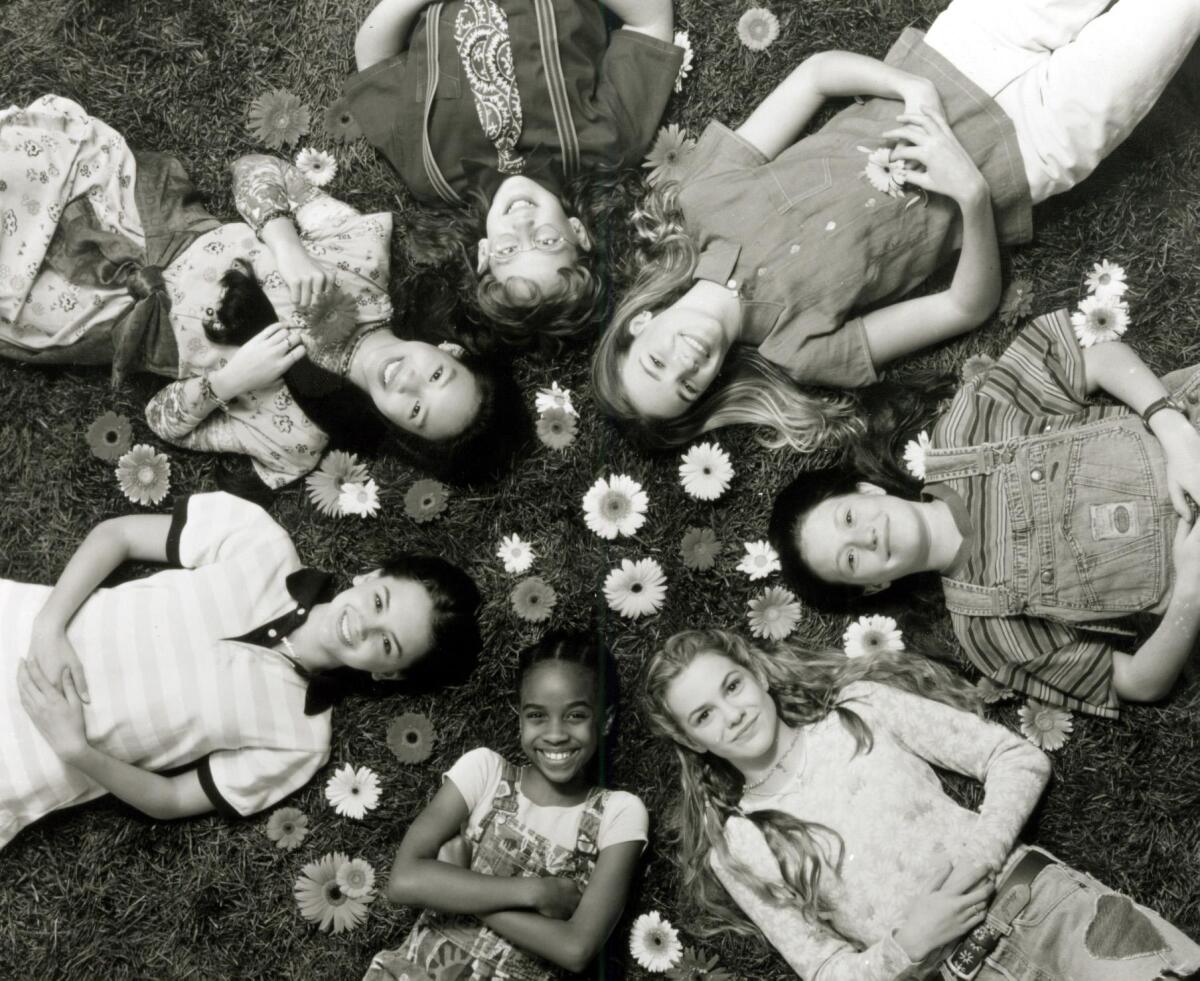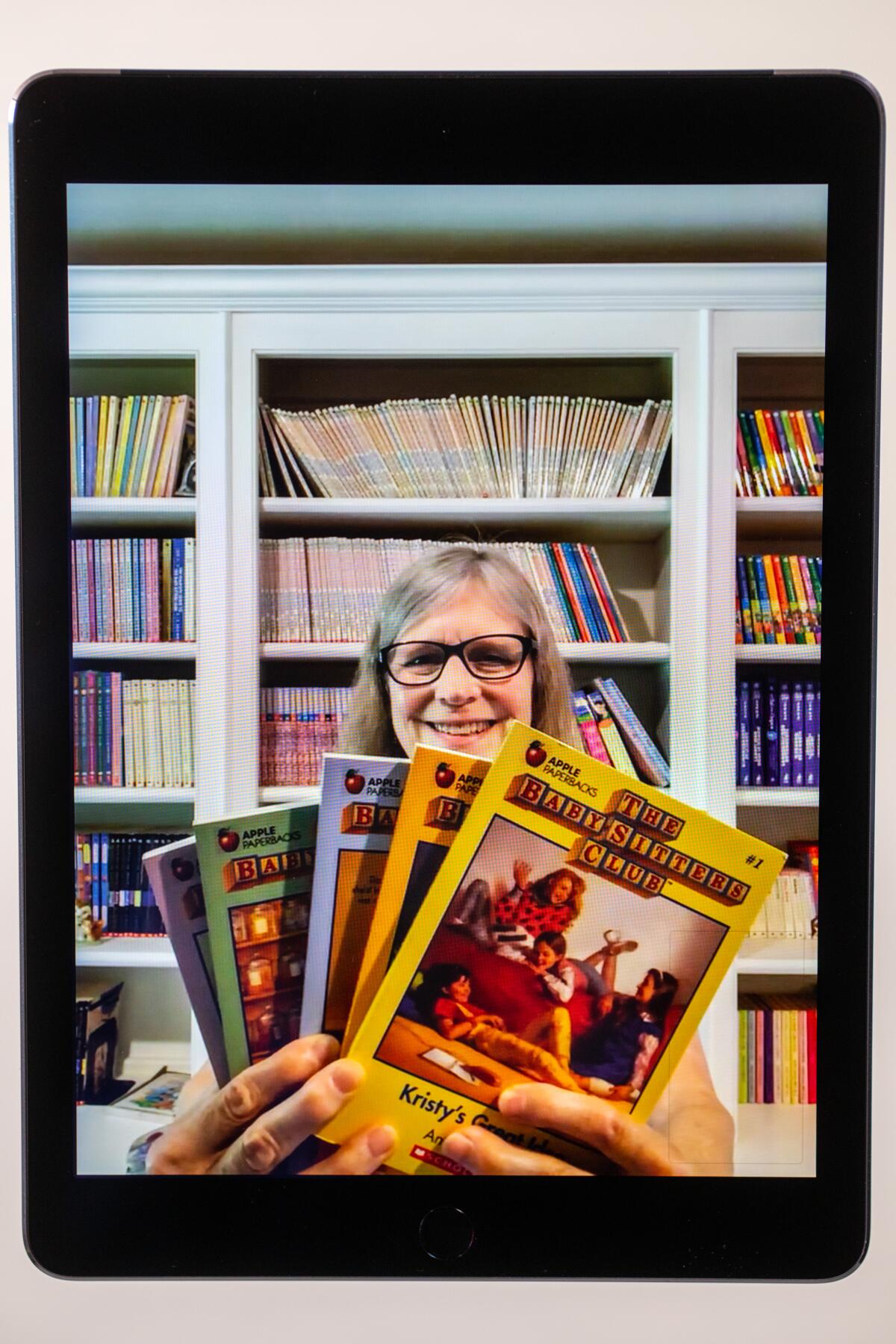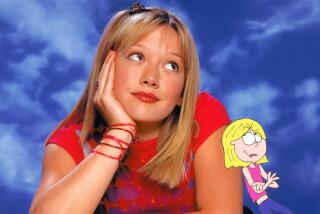Did you adore ‘The Baby-Sitters Club’? The women of Netflix’s version totally get it
- Share via
Countless women who came of age in the ’80s and ’90s have memories of “The Baby-Sitters Club” books that provoke a nostalgic, pastel-hued wave of heart-eyed emojis.
Rachel Shukert, a producer and writer known for her work on “GLOW” and “Supergirl,” received the first book as a birthday present. Scanning the description on the back cover, Shukert, then in elementary school, wasn’t all that intrigued. But one uneventful afternoon she finally cracked open “The Ghost at Dawn’s House,” book No. 9 in the series, clutching the ends of its warm, peach-toned cover with the same steady grip of a kid today clinging to a tablet. She was hooked.
An entire shelf inside her bubblegum-pink room at her family home in Omaha, Neb., was eventually jammed with the recognizable rainbow block of spines (“I kept them very separate and special from all the other books,” Shukert, now 40, says. “The shelf would get bigger and bigger since there were more and more books.”) During recess at Friedel Jewish Academy, on a knoll out of ear shot of the school, she and her friends would talk about the book series, trade copies and sometimes pretend to be the characters.
Growing up in a suburb of Springfield, Mass., Lucia Aniello, best known for her work on Comedy Central’s “Broad City,” vividly remembers how her insatiable appetite for the book series resulted in stacks of free pizza award certificates as part of Pizza Hut’s Book It program. (“My parents owned a pizza restaurant, so I couldn’t use them,” Aniello, 37, notes with a laugh. “I actually ended up kind of becoming popular and I would hand out free pizza slips because I had no use for them.”)
Still fresh is Aniello’s memory of laying in the family’s backyard hammock as a kid, reading book after book until the moon nudged the sun away.
Decades after those formative years reading about the plucky, ragtag group of middle-school babysitters in fictional Stoneybrook in the book series, launched by author Ann M. Martin in 1986, Aniello and Shukert are now responsible for translating the franchise’s binge-reading power into a TV series for the streaming generation. (Shukert is the showrunner of the series, while Aniello serves as a director and executive producer.)
Premiering Friday, the 10-episode reboot opens with a modern wink to an origin story as important to some as Spider-Man’s or Batman’s. Sporty seventh grader Kristy Thomas (Sophie Grace) watches as her single mom, Elizabeth (Alicia Silverstone), is in need of a sitter to watch her youngest son. Elizabeth huffs about young people these days being hard to get in touch with, as well as the high fees of internet-based babysitting services: “When I was a kid, my mother would just call some girl in the neighborhood on a landline,” she says. “And she would answer, because it was part of the social contract.”
Kristy’s great idea is born: a babysitting club.
She enlists her shy bestie Mary Anne Spier (Malia Baker) as secretary, their artistic friend and neighbor Claudia Kishi (Momona Tamada) as vice president, fashionable new girl from New York City Stacey McGill (Shay Rudolph) as treasurer, and eventually environmentally conscious California transplant Dawn Schafer (Xochitl Gomez) as an alternate officer. (Claudia also serves as the resident BSC host because she has a phone — one of those now-vintage transparent landlines with brightly-colored hardware — in her room.)
“When I saw them all together for the first time, that was one of the top five moments of my life,” Shukert says. “Maybe ahead of my wedding, but after having my son.” The way she speaks with reverence about the series, it’s easy to believe she isn’t joking.
That adoration, steeped in childhood memories untouched by the corrosion of time, made for a surreal adaptation process. Shukert says rereading the original book series, which ran until 2000 and has sold more than 180 million copies, she was struck by how she remembered very specific details — like Stacey painting her toenails with pink polish accented by a green dot or Claudia having white tights with plaits all over them or how Eleanor Marshall, one of the kids the girls babysit, was allergic to strawberries. But what came more sharply into focus was how the girls’ environment and experiences shaped how they navigated the world. She points to Kristy as an example.
“She is viewed as being bossy and controlling and has to have all the ideas and she’s such a leader,” Shukert says. “And then you think about Kristy in a kind of emotional context and she’s this kid whose dad walked out on her when she was, like, 6 years old and never called her and had no contact with her family. Her mom has done this on her own. And you’re like, of course she’s controlling. She needs to control her environment because her early life lacks a lot of control. I think I sort of didn’t see that as a kid, because why would you?”

In her early 30s when tapped to write the original book series, Martin has watched the literary saga get a Hollywood filter before. HBO had a short-lived adaptation in 1990 and there was a 1995 feature film, which starred ‘90s all-stars Rachael Leigh Cook and Larisa Oleynik, that grossed less than $10 million. Martin said it was important for her to be involved with the Netflix series, story-wise, from the beginning. She read scripts, offering the occasional note — sometimes practical ones. (For example, in the sixth episode, Claudia’s grandmother Mimi mentions she doesn’t like peaches because she associates them with trauma in her childhood. Martin reminded Shukert that Claudia has an aunt named Peaches who is introduced in book No. 47.) She also visited the show’s set in Vancouver.
“I was just desperate for her approval,” says Shukert, who adds that she received a signed copy of her favorite book in the series, “Little Miss Stoneybrook ... and Dawn,” from Martin during production. “She’s such a huge figure in the lives of many women my age. It was kind of overwhelming.”
“I had a sort of ‘I’m not worthy,’ ‘Wayne’s World’-type response to her,” is how Aniello describes it.
The Netflix series manages to evoke a certain time-capsule quality — it’s infused with the books’ signature sherbet color palette and the girls’ wardrobe seems yanked straight off the book covers — while also feeling current. Shukert and Aniello felt strongly that the girls should feel like an updated version of their literary counterparts, particularly when they’re using cellphones, without diluting their essence.
“It’s definitely for today’s viewers,” Martin, now 64, says over the phone from her home in upstate New York. “But I think it still retains all the parts of the [book] series that young kids fell in love with 35 years ago. Just listening to the things that the characters care about, looking at the way that they’re dressed, how they interact with each other. It’s my girls.”
That remains true even as the group became more diverse on-screen: Mary Anne is biracial, Claudia’s Japanese heritage comes more sharply into view, and Dawn is Latinx.
“The series from the beginning has been about inclusivity,” Martin says. “We wanted to have a diverse cast of characters. So some of the characters have changed a little bit and I hope any kid who watches the show will find themselves when they see this Stoneybrook and the characters.”

A fundamental principal both Shukert and Aniello felt strongly about was infusing the young characters with as much dimension as they’ve given to the adult characters they’ve shaped on “GLOW” and “Broad City,” without sacrificing the angst of middle-school growing pains.
“I feel like ‘GLOW’ and ‘The Baby-Sitters Club’ share a lot of DNA, honestly,” says Shukert, while revealing that “GLOW’s” Dawn (Rebekka Johnson) and Stacey (Kimmy Gatewood) are named after “The Baby-Sitters Club” characters. “It’s this group of women, or girls, who are very different from one another, who come from different backgrounds, and they’re coming together with this shared vision of creating something larger than themselves and being something greater and finding their power in each other.”
Adds Aniello: “We really wanted to make something for young girls that treated them like real people that weren’t glossy in any way. ‘Freaks and Geeks’ was a show we talked a lot about, how they felt as fully fleshed out as adult characters, they just happened to be younger.”
That sometimes meant borrowing from the books’ referential spirit — for example, the series incorporates mentions of “The Handmaid’s Tale,” contemporary artist Elizabeth Peyton and Sun Tzu’s “The Art of War.”
“I realized rereading it, the books were the first time I heard of the movie ‘Rosemary’s Baby,’” Shukert says. “Ann had all these sort of elusive references that were really advanced and made the world feel anchored in reality. I wanted to do that in the series. I think we had a note that kids aren’t going to know who Elizabeth Peyton is. And I was like, ‘Of course they’re not. But now they will.’”

More primal was the desire to really capture the way Martin gave the girls agency and the complex portrait of friendship she presented — which Shukert and Aniello credit for the books’ enduring appeal.
“I’d seen this group of girls who were able to do something and be kind of a big deal in their community, and they did it without adults overseeing it and no one has to explain to them how to run a business,” Shukert says. “And they taught me it’s OK to have conflict, it doesn’t mean a friendship is over. They would argue about the business. They would get jealous of each other. And then they would make up and life went on. It felt real. It didn’t feel like this sort of saccharine version of childhood friendship.”
Conceived after the 2016 election and gestating alongside both the #MeToo movement and broader calls for increased representation of women leaders in politics, entertainment and other fields, its creators hope the Netflix series will emulate the books in shaping girls’ sense of possibility.
“The stuff that you read at this stage in your childhood is kind of the most important thing that you ever read. It informs your work in a way that nothing that you read or consume as an adult really does,” Shukert says. “If you look at current movies, it’s because all of these men were obsessed with ‘Star Wars’ and comic books when they were kids. Everything kind of comes to this filter that you form when you’re a kid. And I feel like we’re in this interesting moment where so many women who are kind of coming into their voices in the culture read these books and were informed by these books. They’re really important and have had such a positive influence. I really think so many of us sort of found our strength in ‘The Baby-Sitters Club.’”
‘The Baby-Sitters Club’
Where: Netflix
When: Any time, starting Friday
Rated: TV-G (suitable for all ages)
More to Read
The complete guide to home viewing
Get Screen Gab for everything about the TV shows and streaming movies everyone’s talking about.
You may occasionally receive promotional content from the Los Angeles Times.







